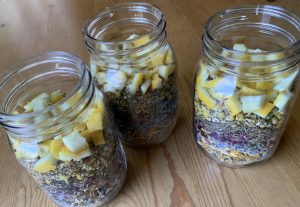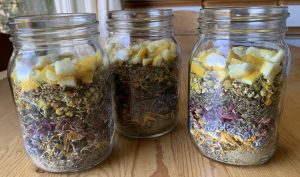Hungary Water: Part 2
March 21, 2022 • 3 Comments
This is the continuation of this  blog describing the recipe and my first try at recreating Hungary Water. I left the test batches to steep for about three months. I waited some months more to let the scents settle down and blend.
blog describing the recipe and my first try at recreating Hungary Water. I left the test batches to steep for about three months. I waited some months more to let the scents settle down and blend.
My first observation is that volume is important. By the time I strained the vegetable matter from my test batches, I didn’t get much yield—maybe half a cup per jar. The results were also very concentrated. When I do this again, I’m going to use at least a quart-sized container and more liquid.
The rosemary scent dominates the results, but that could be because it was the one element that was home grown and therefore freshest. All three bases initially overpowered the scent of the herbs but calmed down with time. The witch hazel version was fairly raunchy when it first brewed but is now the most pleasant of the three. It is a nice addition to a bath and as a facial astringent. I used the cider vinegar version (diluted) to rinse my hair after shampooing it. This is an excellent way to add scent and shine, but please be careful with color-treated hair as the vinegar can be drying. The vodka version was my least favorite. It killed some stubborn weeds in the driveway and probably any other living entity within five yards. I’m pretty sure the driveway glows after dark and the raccoons are building a bomb shelter.
My honest assessment is that a) a greater liquid volume would create a better balance of scents, b) the combination of herbs could possibly be simplified, and c) I need to do more research into a good liquid base for this purpose. The witch hazel is acceptable, but I’d like to keep exploring.
Bottom line: this experiment opened the door to some interesting possibilities for more research and experimentation.
DIY Historical Cosmetics: Queen of Hungary’s Water
April 26, 2021 • 3 Comments
 Queen of Hungary’s Water aka Hungary Water has been one of my favourite scents for as long as I’ve been wearing perfume. It’s herbal rather than sweet, with a clean, bright finish. Though no two blends are exactly the same, lemon and rosemary are usually the dominant notes. As I was making this up, the scent of the herbs was almost dizzying. It’s like a herb garden in a jar.
Queen of Hungary’s Water aka Hungary Water has been one of my favourite scents for as long as I’ve been wearing perfume. It’s herbal rather than sweet, with a clean, bright finish. Though no two blends are exactly the same, lemon and rosemary are usually the dominant notes. As I was making this up, the scent of the herbs was almost dizzying. It’s like a herb garden in a jar.
Some sources claim Queen of Hungary’s Water is the first alcohol-based perfume, or at least the first European one, and dates from the beginning of the fourteenth century. It’s also used as a skin tonic, the herbal ingredients effective against acne and eczema, among other issues. In addition, it can be used to bathe the temples to cure a headache. It is for external use only. Do not drink it or take it as a tincture.
Ingredients are important
There are a lot of different recipes for Hungary Water, but be careful. Beware of recipes that use lemon verbena as a main ingredient as the essential oil of that plant has been linked to sun sensitivity, which can increase the likelihood of sunburn. Lemon balm does not have the same problem.
Try to get organic herbs and essential oils if you can. Good quality dried herbs will store in a cool, dry place until it’s time to make another batch.
Recipe:
Layer the herbs in a wide mouth jar. A mason jar is ideal (bigger is better – the herbs swell once the liquid goes in).
2 tablespoons of lemon balm
2 tablespoons of lavender
2 tablespoons of calendula
2 tablespoons of rose petals
2 tablespoons of chamomile
1.5 tablespoons of comfrey
1 tablespoon of sage
1 tablespoon of rosemary
1 tablespoon of peppermint
1 tablespoon of elderflowers
12 drops of helichrysum oil
Top with chopped lemon peel (1/3 of a lemon rind, pith removed)
Cover the herbs with apple cider vinegar, witch hazel, or vodka. Allow for a couple inches of liquid above the herbs. Store for several weeks, shaking a couple of times a day.
As this is my first time making this, I’ve done one each using the vinegar, witch hazel, and vodka to see which turns out best. Please see this blog for the results.
I based this recipe on several existing sources both in books and online, including this one, this one, and this one. I’ll adjust the ingredients as time goes on until I create my own preferred combination. For now, I’m sharing my experiment with you!
Post Script
Please note:
Yes, I am a writer of vampiric fiction, but before you get excited, dear reader, the Hungarian noble in question is not Elizabeth Bathory of “bathing in the blood of virgins” fame, nor does this post describe a bracing post-blood tonic or solution for that awful bathtub ring. I suggest a foaming cleanser with plenty of bleach for that.








